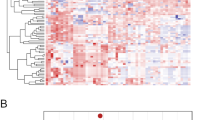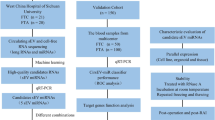Abstract
Fine needle aspiration cytology (FNAC) plays an essential role in the evaluation of thyroid nodules especially for the category of follicular neoplasms (FN) representing 25 % of all thyroid cases including different neoplastic entities. Hence, one of the most promising areas is the application of molecular tests to FNAC. Among them, microRNAs (miRNA),identified as negative (post-transcriptional) gene expression regulators involved in tumor development, are likely to discriminate among FNs. Limited data explored the use of miRNAs on FNAC as well as their role in the malignant risk stratification. We aimed to define whether liquid-based cytology (LBC) is a valid method for miRNA evaluation. From June 2014 to March 2015, we enrolled 27FNs with histological follow-up. In the same reference period, 13 benign nodules (BN) and 20 positive for malignancy (PM) were selected as controls. Histologically, FNs resulted in 14 malignancies (3 papillary thyroid carcinoma-PTC and 11 follicular variant of PTC-FVPC) and 13 follicular adenomas (FA). The 20 PMs included two FVPC, 16 PTC and two medullary thyroid carcinoma (MTC). Five miRNAs (10b, 92a, 221/222 cluster, and 375) were studied on LBC and quantified by real-time PCR. Only miR-375 was over-expressed in the FNs diagnosed as carcinomas and in the PMs. A cut-off of 12 miR-375/U6 relative ratio recognized all BNs and 95 % PMs. Specifically, in each category, FVPCs and PTCs did not show any difference while MTCs had the highest value. miR-375 shows 97.1 % sensitivity, 100 % specificity, 96.3 % negative predictive value (NPV), 100 % positive predictive value (PPV), and 98.3 % diagnostic accuracy. LBC is suitable for miRNAs evaluation. miR-375 resulted over-expressed in all malignant FNs and 95 % PMs. It may represent a valid aid in ruling out BNs and supporting PTCs and/or FVPCs.


Similar content being viewed by others
References
J.A. Sosa, J.W. Hanna, K.A. Robinson et al., Increases in thyroid nodule fine-needle aspirations, operations, and diagnoses of thyroid cancer in the United States. Surgery 154, 1420–1426 (2013)
C.M. Kiernan, J.T. Broome, C.C. Solozano, The Bethesda system for reporting thyroid cytopathology: a single-center experience over 5 years. Ann. Surg. Oncol. 21, 3522–3527 (2014)
S. Ali, Thyroid cytopathology: Bethesda and beyond. Acta Cytol. 55, 4–12 (2011)
H.H. Wang, Reporting thyroid fine-needle aspiration: literature review and a proposal. Diagn. Cytopathol. 34, 67–76 (2000)
D.N. Poller, A.K. Ibrahim, M.H. Cummings et al., Fine-needle aspiration of the thyroid. Importance of an indeterminate diagnostic category. Cancer Cytopathol. 90, 239–244 (2000)
G. Fadda, E.D. Rossi, M. Raffaelli et al., Follicular thyroid neoplasms can be classified as low and high risk according to HBME-1 and Galectin 3 expression on liquid based fine needle cytology. Eur. J. Endocrinol. 165, 447–453 (2011)
F. Pagni, M. Prada, P. Goffredo et al., ‘Indeterminate for malignancy’ (TIR3/Thy3 in the Italian and British systems for classification) thyroid fine needle aspiration (FNA) cytology reporting: morphological criteria and clinical impact. Cytopathol 25, 170–176 (2014)
J. Diggans, S.Y. Kim, Z. Hu et al., Machine learning from concept to clinic: reliable detection of BRAFV600E DNA mutations in thyroid nodules using high-dimensional RNA expression data. Pac. Symp. Biocomput. 20, 371–382 (2015)
J.F. Krane, P.A. Vanderlaan, W.C. Faquin et al., The atypia of undetermined significance/follicular lesion of undetermined significance:malignant ratio. Cancer Cytopathol. 120, 111–116 (2012)
A.S. Ho, E.E. Sarti, K.S. Jain et al., Malignancy rate in thyroid nodules classified as Bethesda category III (AUS/FLUS). Thyroid 24, 832–839 (2014)
H. Chen, I. Izevbaye, F. Chen et al., Recent advances in follicular variant of papillary thyroid carcinoma. N. Am. J. Med. Sci. 5, 212–216 (2012)
Walts AE, Mirocha JM, Bose S. Follicular variant of papillary thyroid carcinoma (FVPTC): histological features, BRAF V600E mutation, and lymph node status. J. Cancer Res. Clin. Oncol. 141, 1749–1756 (2015). doi:10.1007/s00432-015-1939-9
E.S. Cibas, S.Z. Ali, The Bethesda system for reporting thyroid cytopathology. Thyroid 19, 1159–1165 (2009)
British Thyroid Association, Royal College of Physicians Guidelines for the management of thyroid cancer, 3rd edn. (RCP, London, 2014)
F. Nardi, F. Basolo, A. Crescenzi et al., Italian consensus for the classification and reporting of thyroid cytology. J. Endocrinol. Invest. 37, 593–599 (2014)
B.C.G. Freitas, J.M. Cerutti, Genetic markers differentiating follicular thyroid carcinoma from benign lesions. Mol. Cell. Endocrinol. 321, 77–85 (2010)
H.G. Correia-Rodrigues, A.A. Nogueira De Pontes, L.F.F. Adan, Use of molecular markers in samples obtained from preoperative aspiration of thyroid. Endocr. J. 59, 417–424 (2012)
M.N. Nikiforova, Y. Nikiforov, Molecular diagnostics and predictors in thyroid cancer. Thyroid 19, 1351–1361 (2009)
G. Fadda, E.D. Rossi, Liquid based cytology in fine needle aspiration biopsies of the thyroid gland. Acta Cytol. 55, 389–400 (2011)
D. Dabbs, C.S. Abendroth, R.T. Grenko et al., Immunocytochemistry on the Thin-prep processor. Diagn. Cytopathol. 17, 388–392 (1997)
A. Longatto-Filho, A.E. Goncalves, O. Martinho et al., Liquid based cytology in DNA-based molecular research. Anal. Quant. Cytol. Histol. 31, 395–400 (2009)
E.D. Rossi, M. Martini, S. Capodimonti et al., Diagnostic and prognostic value of immunocytochemistry and BRAF mutation analysis on liquid based biopsies of thyroid neoplasms suspicious for carcinoma. Eur. J. Endocrinol. 168, 853–859 (2013)
Y.E. Nikiforov, D.L. Steward, T.M. Robinson-Smith et al., Molecular testing for mutations in improving the fine needle aspiration diagnosis of thyroid nodules. J. Clin. Endocrinol. Metab. 94, 2092–2098 (2009)
H. Mazeh, I. Mizrahi, D. Halle et al., Development of a microRNA-based molecular assay for the detection of papillary thyroid carcinoma in aspiration biopsy samples. Thyroid 21, 111–118 (2011)
R. Shen, S. Liyanarachchi, W. Li et al., MicroRNA signature in thyroid fine needle aspiration cytology applied to “atipia of undetermined significance” cases. Thyroid 22, 9–16 (2012)
M.N. Nikiforova, S.I. Chiosea, Y.E. Nikiforov, MicroRNA expression profiles in thyroid microRNAs in thryoid fine needle aspiration biopsy samples. Thyroid 22, 285–291 (2012)
M.N. Nikiforova, G.C. Tseng, D. Steward et al., MicroRNA expression profiling of thyroid tumors: biological significance and diagnistic utility. J. Clin. Endocrinol. Metab. 93, 1600–1608 (2008)
H. Mazeh, Y. Levy, I. Mizrahi et al., Differentiating benign from malignant thyroid nodules using micro ribonucleic acid amplification in residual cells obtained by fine needle aspiration biopsy. J. Surg. Res. 180, 216–221 (2013)
X.M. Keutgen, F. Filicori, M.J. Crowley et al., A panel of four miRNAs accurately differentiates malignant from benign indeterminate thyroid lesions on fine needle aspiration. Clin. Cancer Res. 18, 2032–2038 (2012)
P. Pallante, R. Visone, M. Ferracin et al., MircoRNA deregulation in human thyroid papillary carcinomas. Endocr. Relat. Cancer 13, 497–508 (2006)
F. Weber, R.E. Teresi, C.E. Broelsch et al., A limited set of human microRNA is deregulated in follicular thyroid carcinoma. J. Clin. Endocrinol. Metab. 91, 3584–3591 (2006)
M.T. Tetzlaff, A. Liu, X. Xu, S.R. Master et al., Differential Expression of miRNAs in papillary thyroid carcinoma compared to multinodular goiter using formalin fixed paraffin embedded tissues. Endocr. Pathol. 18, 163–173 (2007)
Y.T. Chen, N. Kitabayashi, X.K. Zhou et al., MicroRNA analysis as a potential diagnostic tool for papillary thyroid carcinoma. Mod. Pathol. 21, 1139–1146 (2008)
S.Y. Sheu, F. Grabellus, S. Schwertheim et al., Differential miRNA expression profiles in variants of papillary thyroid carcinoma and encapsulated follicular thyroid tumors. Br. J. Cancer 102, 376–382 (2010)
Y. Peng, C. Li, D.C. Luo et al., Expression profile and clinical significance of microRNAs in papillary thyroid carcinoma. Molecules 19, 11586–11599 (2014)
C.K. Chou, R.F. Chen, F.F. Chou et al., miR-146 is highly expressed in adult papillary thyroid carcinoma with high risk features including extrathyroidal invasion and the BRAF (V600E) mutation. Thyroid 20, 489–494 (2010)
L. Yip, L. Kelly, Y. Shuai et al., MicroRNA signature distinguishes the degree of aggressiveness of papillary thyroid carcinoma. Ann. Surg. Oncol. 18, 2035–2041 (2011)
J. Hudson, E. Duncavage, A. Tamburrino et al., Over expression of miR-10a and miR-375 and down regulation of YAP1 in medullary thyroid carcinoma. Exp. Mol. Pathol. 95, 62–67 (2013)
J.W. Yan, J.S. Lin, X.X. He, The emerging role of miR-375 in cancer. Int. J. Cancer 135, 1011–1018 (2013)
T. Jikuzono, M. Kawamoto, H. Yoshitake et al., The miR-221/222 custer, miR-10B and miR-92a are highly upregulated in metastatic minimally invasive follicular thyroid carcinoma. Int. J. Oncol. 42, 1858–1868 (2013)
P. Agretti, E. Ferrarini, T. Rago et al., MicroRNA expression profile help to distinguish benign nodules from papillary thyroid carcinomas starting from cells of fine needle aspiration. Eur. J. Endocrinol. 167, 393–400 (2012)
Y. Zhang, Q. Zhong, X. Chen et al., Diagnostic value of microRNAs in discriminating malignant thyroid nodules from benign ones on fine needle aspiration samples. Tumor Biol. 35, 9343–9353 (2014)
M. Dettmer, A. Perren, H. Moch et al., Comprehensive microRNA expression profiling identifies novel markers in follicular variant of papillary thyroid carcinoma. Thyroid 23, 1383–1389 (2013)
M. Dettmer, A. Vogetseder, M.B. Durso et al., MicroRNA expression array identifies novel diagnostic markers for conventional and oncocytic follicular thyroid carcinomas. J. Clin. Endocrinol. Metab. 98, E1–E7 (2013)
American Joint Commission on Cancer (AJCC) Cancer Staging Atlas, 2nd edn. (2013)
M. Xing, BRAF mutationin papillary thyroid cancer: pathogenic role, molecular bases and clinical implications. Endocr. Rev. 28, 742–762 (2007)
T.H. Kim, Y.J. Park, J.A. Lim et al., The association of the BRAFV600E mutation with prognostic factors and poor clinical outcome in papillary thyroid cancer. Cancer 118, 1764–1773 (2012)
M. Drage, B. Howitt, J. Krane, J. Barletta et al., Fine needle aspiration diagnoses of non-infiltrative, non-invasive follicular variant of papillary thyroid carcinoma. Mod. Pathol. 28, S-134A (2015)
Acknowledgments
The authors thank Mrs. Elisabeth Boyle for the invaluable support with the English language.
Funding
This research did not receive any specific grant from any funding agency in the public, commercial, or not-profit sectors.
Author information
Authors and Affiliations
Corresponding author
Ethics declarations
Conflict of interest
The authors have no conflict of interests
Additional information
The abstract was prized as the best oral presentation during the 39th European congress of cytology held in Milan September 2015.
Rights and permissions
About this article
Cite this article
Rossi, E.D., Bizzarro, T., Martini, M. et al. The evaluation of miRNAs on thyroid FNAC: the promising role of miR-375 in follicular neoplasms. Endocrine 54, 723–732 (2016). https://doi.org/10.1007/s12020-016-0866-0
Received:
Accepted:
Published:
Issue Date:
DOI: https://doi.org/10.1007/s12020-016-0866-0




